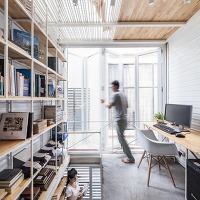
Our newly-built office plan. The site is located in a suburb of Nagoya City, near the last stop of a metro station, and facing a major arterial road. A large development project being undertaken in the surrounding area, will transform the site in years to come. The following points were focused on to carry out the project: Creating the image of a fresh space that will play a key role in our company’s future development. Encouraging rich communication between the staff. Exploring the possibilities of a wooden structure.


The construction was planned with the following considerations in mind: Firstly, concerning the placement of pillars, 30 pillars were placed in a hash-tag layout allowing the creation of a structure that has no load bearing walls inside. Secondly, with regard to the slabs, free-arrangement of the slabs produced differences in height allowing the staff to choose their own custom spaces in the office. Thirdly, regarding the exterior, same-sized openings cover all four walls and give a classic look to the main facade, and provide it with the impression of durability.

All of these elements came together to create an intentionally designed space that could bear unintended and surprising forms of functionality. Characteristics such as windows cut-off by slabs, windows placed in inaccessible locations, and the staircase peaking out from between slabs contribute to a rich, unusual space?a space that provides the feeling of being in a grove, accomplished through the sunlight shining down via windows on the walls surrounding the inside, even though the space was created artificially. The rule that presided over the production of this space may appear to recall postmodern architecture. However, if postmodern architecture is recognized as specializing in meaning, this structure has both the strength of meaning and space. What is “postmodern” originally supposed to mean? The reconsideration of historical value is imbued in this architecture. Text offer: Mamiya Shinichi Design Studio

필라그로브 이 건물은 마미야 시니치 디자인 스튜디오의 새로 지어진 사무실이다. 대지는 나고야 교외에 한 지하철역의 마지막 정류장 근처에 주요 간선 도로를 마주 보고 자리 잡고 있다. 주변 지역에서 대규모 개발 프로젝트가 진행되고 있기 때문에 수년 사이에 이곳이 변형될 것이다. 이 프로젝트를 수행하기 위해 다음과 같은 사항에 중점을 두었다. 회사의 미래 발전에 핵심적인 역할을 할 수 있는 신선한 이미지의 공간을 창조하는 것, 직원들의 풍부한 의사소통 장려하는 것, 목조 구조의 가능성을 탐색하는 것이 바로 그것이다.


시공에는 다음과 같은 사항을 염두에 두고 진행했다. 첫째, 내부의 내력벽이 없는 구조가 가능하도록 30개의 기둥을 해시태그의 형태로 배치하였다. 또한, 직원들이 자신만의 맞춤 공간을 선택할 수 있도록 슬래브를 자유롭게 배치하여 높이의 차이를 만들었다. 마지막으로는 같은 크기의 개구부를 4개의 벽면에 모두 계획하여 입면에 고전적인 형태를 부여했다. 이는 내구성이 높은 인상을 표현한다. 이러한 모든 요소는 의도적으로 설계된 공간을 만들기 위한 노력이었다.

비록 인위적으로 만든 공간이지만 슬래브에 의해 나뉘거나 접근이 불가능한 곳에 자리 잡은 창문, 슬래브 사이로 살짝 보이는 계단 등의 요소는 마치 햇살이 비추는 과수원에 있는 듯, 풍부하고 독특한 공간을 만들어 낸다. 이러한 구조와 규칙은 의미와 공간의 힘을 모두 갖는 포스트모던 건축을 떠올리게 한다. 원래 ‘포스트모던’이라는 것은 무엇을 의미하는가? 이 건물에는 역사적 가치에 대한 재검토라는 의미가 담겨있다. 글 제공: 마미야 신이치 디자인 스튜디오



Architect Mamiya Shinichi Design Studio
Location Aichi prefecture, Japan
Site area 171.8 m2
Builing area 134.64m2
Gross Floor Area 250.02m2
Prinicipal architects Shinichi Mamiya, Rintaro Kakeno
Strucutral engineer Tatsumi Terado
Photographer Toshiyuki Yano
해당 프로젝트는 건축문화 9월호(Vol. 436)에 게재 되었습니다.
The project was published in the September issue of the magazine (Vol. 436)
'Architecture Project > Office' 카테고리의 다른 글
| DAGONG (0) | 2017.11.22 |
|---|---|
| OFFICE dmvA (0) | 2017.11.21 |
| SYMBIOSIS (0) | 2017.11.17 |
| SMA254 (0) | 2017.11.16 |
| FOREST MEWS (0) | 2017.11.15 |
마실와이드 | 등록번호 : 서울, 아03630 | 등록일자 : 2015년 03월 11일 | 마실와이드 | 발행ㆍ편집인 : 김명규 | 청소년보호책임자 : 최지희 | 발행소 : 서울시 마포구 월드컵로8길 45-8 1층 | 발행일자 : 매일







